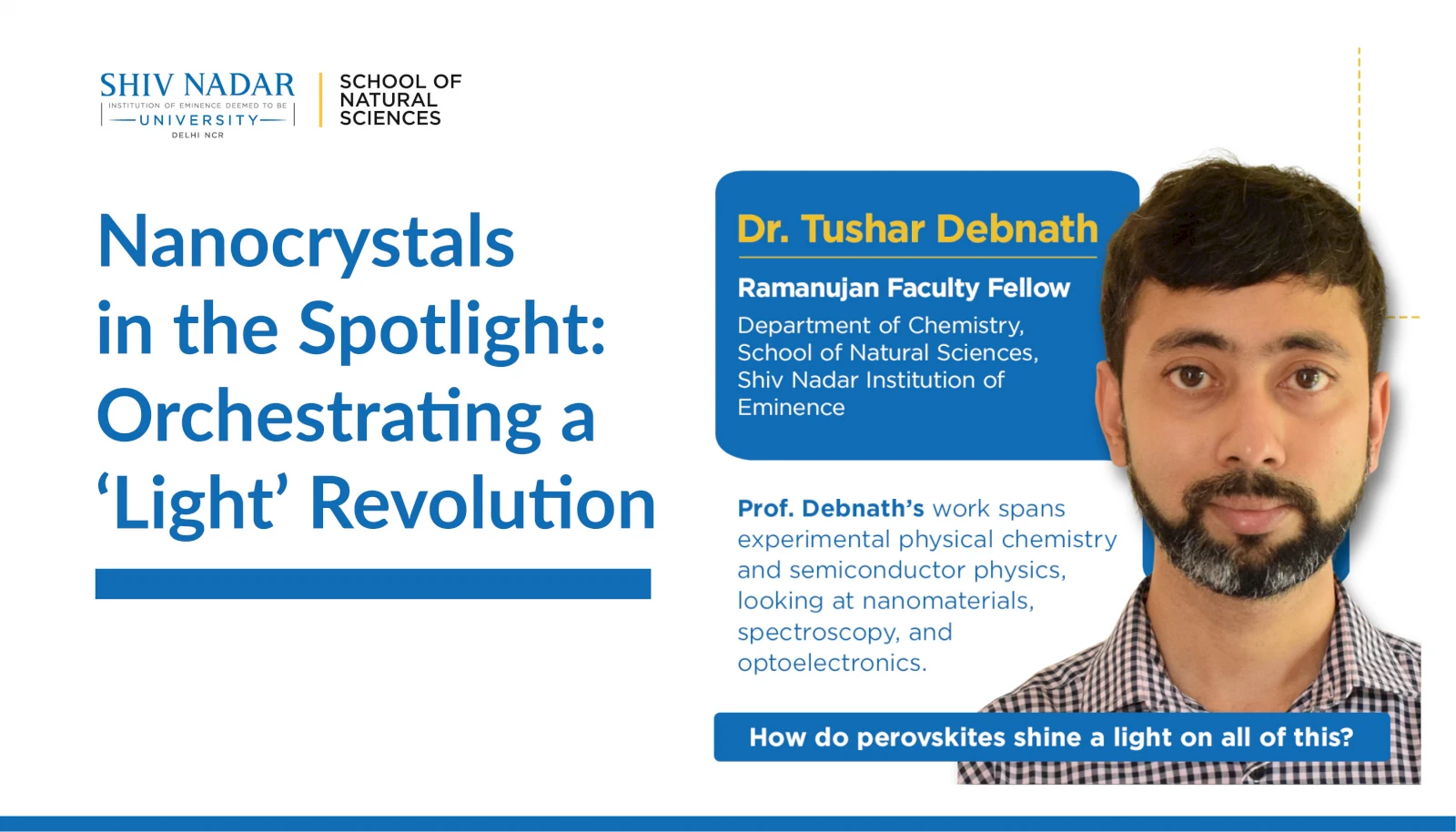Nanocrystals in the Spotlight: Orchestrating a ‘Light’ Revolution
In the rapidly evolving world of optoelectronics, where light and matter interact on timescales of trillionths of a second, Dr. Tushar Debnath and his team at the School of Natural Sciences, Shiv Nadar Institution of Eminence, have been orchestrating a ‘light’ revolution. With three prominent publications in 2025, his group’s work on perovskite nanomaterials is reshaping how the field approaches energy transfer, quasiparticles, and light–matter coupling at the nanoscale.
Perovskites are minerals with a specific crystal structure similar to the original perovskite, calcium titanate, discovered by German mineralogist Gustavus Rose, and named after Russian mineralogist Lev Perovski.
Commenting on the importance of the crystal, Dr. Tushar Debnath says, “Perovskites have been in the spotlight as potential high-efficiency and low-cost materials for solar cells. They promise better and longer performance than traditional silicon-based solar cells.” Indeed, there is a significant amount of research happening on this globally.
Earlier this year, Dr. Tushar Debnath’s team examined unique energy transfer dynamics in manganese (Mn)-doped CsPbCl₃ perovskite nanocrystals just billionths of a meter wide, in which some lead atoms are replaced by manganese. When these crystals absorb light, they produce excitons, which are ‘excited’ bound electron–hole pairs and, in some cases, biexcitons (two bonded excitons).
“While studies typically only track excitons by watching certain colors fade in what is called a ‘bleaching signal’, our work also analyzed ‘induced’ absorption signals, which appear when excitons transition into biexcitons”, he adds. These overlooked signals can provide a more precise way to study semiconductor nanocrystals, which are crucial for designing efficient light-emitting devices, solar cells, lasers, and other optoelectrical devices.
Diving further into nanoparticles, Dr. Tushar Debnath’s team reported the first clear observation of a new hybrid quasiparticle, the plexciton, in a halide (halogen-bonded) perovskite material. Using gold nanoparticles attached to ultrathin layers of perovskite nanoplatelets (ultrathin sheets), they observed the formation of a plexciton that combines the properties of both. Where excitons would have lost their energy through vibrations, they observed that gold made this scattering almost disappear, offering a way to control exciton lifetimes and charge production. This work opens the door to advance non-linear optoelectrical applications such as optical switches, optical sensors, and laser technologies.
The group also studied a way for energy to move directly from one material to another via Förster Resonance Energy Transfer (FRET). They developed nanocomposites that combine 2D perovskite nanoplatelets and zero-dimensional quantum dots. They found the thickness of the perovskite sheets determines the colour of the light they emit, and that very thin sheets achieve a near-perfect FRET efficiency, while thicker ones barely transferred energy at all. This simple thickness-tuning method offers a brilliant way to engineer nanomaterials for optimal energy transfer. “This could allow us to develop more efficient solar cells, lasers, LEDs, and photo detectors where energy can be converted to light with minimal loss,” says Dr. Tushar Debnath.
Dr. Tushar Debnath’s fascination with perovskites dates back further, to his ground-breaking 2022 study on water-triggered changes in perovskite nanocrystals. At the time, water was considered damaging to the material, rapidly degrading its structure. His team instead showed that water, if used right, could be used to trigger a controlled chemical transformation. “While many research groups have been working towards overcoming the water sensitivity of perovskite nanocrystals, we studied ways in which this water sensitivity can be used constructively,” he explains. That counterintuitive insight has since inspired multiple follow-up studies and remains an active thread of research in his group.
What ties all of this together is a curiosity-driven focus on uncovering the hidden rules that govern light–matter interactions in the world of complex nanostructures. Whether it is identifying overlooked signatures of biexcitons, creating a new hybrid quasiparticle, or achieving near-perfect energy transfer between components on a nanoscale, each discovery opens a new door to physico-chemical architectures not previously understood.
By mastering these ultrafast processes, Dr. Tushar Debnath’s group is laying the groundwork for optoelectrical technologies that could be more efficient, more compact, and more versatile, from quantum light sources to high-efficiency solar cells.
“In our field,” he reflects, “we measure in femtoseconds, but think in decades, about where this knowledge can take us.” If the pace and scope of his recent work are any indication, the answers that emerge from his lab may well help define the future of optoelectronics.
We are excited to see more of Dr. Tushar Debnath’s ‘colourful’ work!
